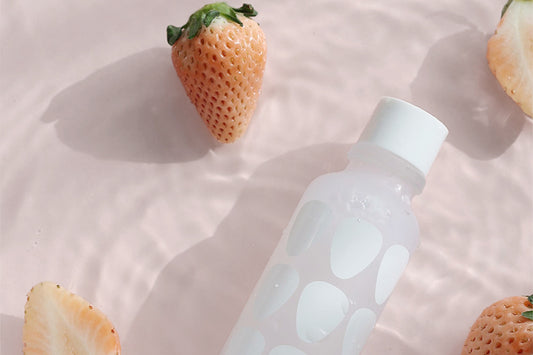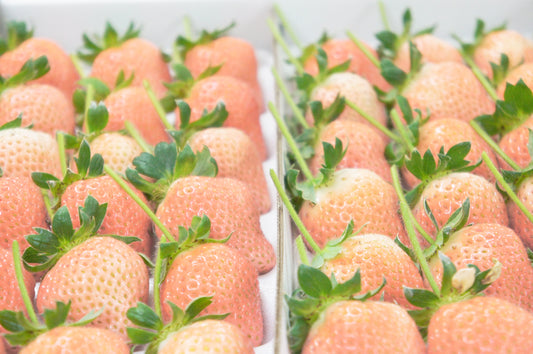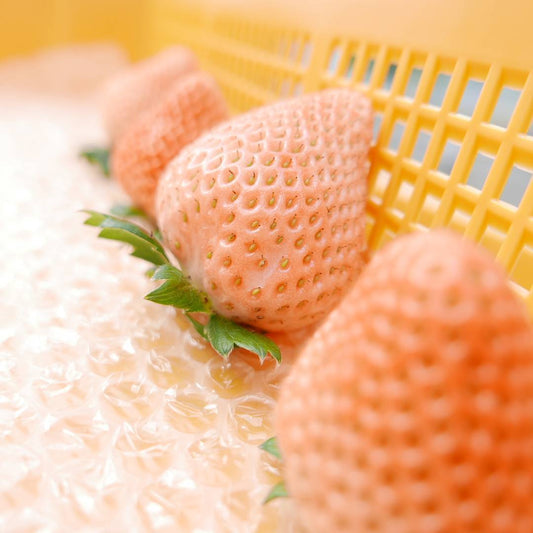What is the origin of white strawberries?
 Hatsukoi no Kaori (scent of first love)
Hatsukoi no Kaori (scent of first love)Cute white strawberries that are slightly pink even when ripe! The precursor dates back to the birth of "Hatsukoi no Kaori" meaning "scent of first love" (cultivar registration: 2009). We interviewed Miyoshi Agri-Tech & Co.,Ltd., which spent 20 years developing "Hatsukoi no Kaori". In the process of creating a new variety, a white variety was created by chance, and they worked with a breeder in Fukushima Prefecture to fix the variety so that the same strawberry would be produced every time. The most challenging aspect was selecting a variety that had three qualities: whiteness, sweetness, and scent. It is a variety that has been perfected not only for its white appearance, but also for its delicious taste.
"Hatsukoi no Kaori" has a refreshing sweet strawberry scent. It has a low acidity and a juicy sweetness with a sugar content of 12-17 degrees.
 Tokun
TokunIn 2011, "Tokun" was registered as a cultivar by the National Agriculture and Food Research Organization. From "Kurume IH1" (cultivar registration: 2005), which is a hybrid between a wild species (Fragaria nilgerrensis) with small white fruit and a scent similar to peaches, and "Toyonoka", it was developed with a focus on improving fruit appearance and yield.
“Tokun” is characterized by its peach-like, rich aroma. The fruit is slightly soft and you can enjoy the sweetness of fresh strawberries.
Since then, new varieties of white strawberries such as "Awayuki" (registered in 2013), "Yuki Usagi" (registered in 2014), and "Tenshi no Mi" (registered in 2014) have continued to be introduced one after another!
What are the nutritional components of strawberries?

Strawberries are rich in vitamin C, containing 62mg per 100g. Eating 161g of strawberries, which is about 5-6 berries, allows you to consume the recommended daily intake of vitamin C for adults, which is 100mg (source: "Dietary Reference Intakes for Japanese 2020" by the Ministry of Health, Labour and Welfare). Vitamin C is a nutrient that helps maintain the health of the skin and mucous membranes, and also has antioxidant properties.
Strawberries also contain a lot of folate, which belongs to the vitamin B group. Folate is a nutrient that helps with the formation of red blood cells and contributes to the normal development of fetuses.
| Composition of raw strawberries | /100g |
| Ascorbic acid | 62mg |
| Folate | 90 μg |
| Dietary fiber, total | 1.4g |
In a study comparing the contribution of ellagic acid, vitamin C, and anthocyanins in strawberries to the antioxidant activity of strawberries, it was found that ellagic acid contributed the most to the antioxidant activity of strawberries, followed by vitamin C.
Reference: 曽根ら(2017)アスコルビン酸含量が多く抗酸化活性の高い促成栽培用イチゴ新品種「おいC ベリー」農研機構研究報告 九州沖縄農業研究センター 第66号
Why are white strawberries white? What are the characteristics of the components of white strawberries?
Why do white strawberries remain white even when ripe? It is because they contain less anthocyanin, a type of polyphenol.
According to a research presentation, as a result of examining the total polyphenol content in 5 cultivars of strawberries (4 cultivars of red strawberries and "Tokun"), "Tokun" has the second highest content after "Sachinoka".
Reference: 宇野ら(2016)イチゴ品種におけるヒスチジンデカルボキシラーゼの活性阻害率の評価、園学研15別1, p319.
In a study, among 11 cultivars of strawberries, "Tokun" was the most effective in inhibiting the activity of histidine decarboxylase, which synthesizes histamine, which causes allergies, in the human body. "Tokun" had an inhibitory effect 10 times higher than that of the lowest cultivar, and this effect was moderately correlated with total polyphenol content.
Reference: Uno et al. (2017) Inhibition of recombinant human histidine decarboxylase activity in different strawberry cultivars. Acta Physiol Plant, 39, 134-139.




